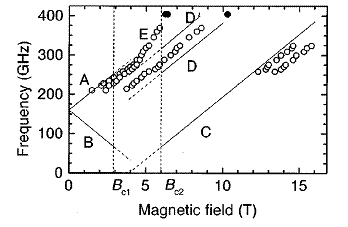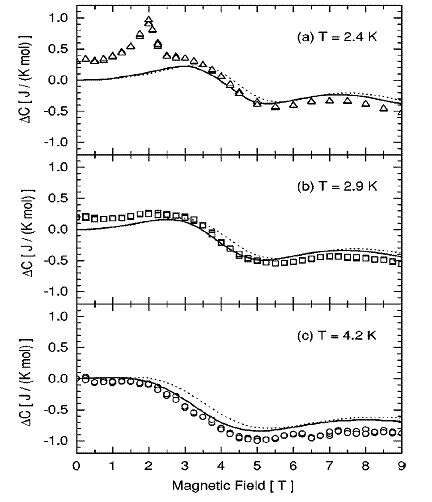BOUND MAGNON STATES
A. Orendáčová, M. Orendáč, A. Feher, E. Čižmár, J. Černák, S. Gabáni, K. Flachbart
The energy spectrum of magnetic excitations in spin chains with the ordered ground state consists of usual one-magnon excitations and two kinds of two-magnon bound states; exchange-bound magnon states (EBS) and rather exotic single-ion bound magnon states (SIBS). In the limit of extremely large easy-axis anisotropy the EBS can be viewed as correlated single spin flips located on two different lattice sites moving along the chain while SIBS can be constructed by two spin flips at a single lattice site. The dominance of EBS or SIBS is controlled by the D/J ratio; for weak easy-axis anisotropy D and strong exchange coupling the spectrum is dominated by EBS while for large D the role of two modes is interchanged. As was shown by Papanicolaou et al. [1, 2] the presence of both nonlinear spin modes can occur also in the ferromagnetic chains from XY1 phase and „large-D” phase in so-called “magnon” regime which can be achieved by applying sufficiently strong magnetic field oriented parallel to the z-axis. Similarly as in the easy-axis chains, SIBS mode dominates the spectrum in the „large-D” phase while in the XY1 phase SIBS diminishes. The critical value of magnetic field required for the ground-state transition from XY/“large-D” to the saturated spin polarized phase has been determined Bc = D/gmB while in antiferromagnetic “large-D” chains, the transition point is extended to the critical region Bc1 < B < Bc2. The physics of “low-field” phase (B < Bc1) is characterized by a persistence of a disordered singlet ground state typical for “large-D” phase in zero magnetic field. The saturated phase (B > Bc2) is characterized by an ordered ferromagnetic ground state with all spins oriented along the magnetic field. The elementary excitations from the ground state are magnons with a corresponding resonance line. Bound magnon states should demonstrate themselves in EPR spectrum as a resonance band with the boundaries depending on the strength of the intrachain exchange coupling.
The electron paramagnetic resonance (EPR) data of Ni(en)2Ni(CN)4, (NENC) have been analyzed in the frame of this theory [3]. Since NENC is antiferromagnet, it was found that the “excitonic” regime persists up to Bc1 = 2.9 T. In this region excitonic resonance transitions are presented by A, B lines (Fig.1). Above the saturated field Bc2 = 6 T, the “magnon” regime is completely set up and it is accompanied by the appearance of two resonance lines.

Fig.1
The lower line (C) is ascribed to one-magnon excitations while the upper one (between D, D’) has been ascribed to single-ion bound states. The shift of this line towards lower frequencies mentioned in [2] results from the effect of intrachain exchange coupling. It should be noted that the EPR data have been analyzed within the theory which is focused only on the “exciton” and “magnon” regimes and no attention was devoted to the critical region because of the complexity of the ground state which could not be solved within the used theoretical approach. Despite the limits of the used model, NENC is the first “large-D” material in which the existence of single-ion bound states has been experimentally proved. Our work directly triggered further theoretical response focused on the physics of intermediate phase Bc1 < B < Bc2. In agreement with NENC experiment [3], Mikeska et al. [4] exactly explained the origin of two resonance lines appearing already in the critical region and extending to “magnon” region. Furthermore, gapless excitations from a nontrivial ground state are predicted falling to a continuum with the boundaries detectable by EPR technique at sufficiently low temperatures with respect to J.
While the systems from „large-D” phase are characterized in the “magnon” regime by a dominance of the SIBS spin mode through the entire Brillouin zone, its influence on the spin dynamics is partially reduced in the systems from XY1 phase. Such situation occurs e.g. in the S = 1 ferromagnetic chain material CsNiF3 in the longitudinal field above 6 T when “magnon” regime is set up. Theoretical calculations of specific heat of CsNiF3 have been performed at sufficiently low temperatures, T » 0.1 J/kB, (J/kB » 24 K, D/kB » 8 K) in the magnetic field swept from 0 to 9 T to map the transition between the “XY1” and “magnon” regimes [5]. It was shown that this transition is accompanied by a double maximum which cannot be explained only within a simple diluted magnon approximation and nonlinear excitations must be considered. These calculations have been experimentally verified [6] by our specific heat measurements of C vs. B dependence in CsNiF3 at various constant temperatures and fields up to 9 T (Fig.2).

Fig.2
Since the compound undergoes a phase transition to the ordered state at Tc = 2.7 K, we chose the temperatures below and above the phase transition to test the effect of interchain coupling which was not considered in the theoretical calculations [5]. Our measurements confirmed the expected double maximum with a saddle at about 5.5 T and an inflection point at the critical field Bc » 6 T. The effect of interchain correlations is clearly visible in low fields and low temperatures, but it cannot overlap the main features calculated for one-dimensional ferromagnet.
[1] N. Papanicolaou, G.C. Psaltakis, Phys. Rev. B 35 (1987) 342.
[2] N. Papanicolaou, A. Orendáčová, M. Orendáč, Phys. Rev. B 56 (1997) 8786.
[3] M. Orendáč, S. Zvyagin, A. Orendáčová, M. Sieling, B. Luthi, A. Feher, M.W. Meisel, Phys. Rev. B 60 (1999) 4170.
[4] A.K. Kolezhuk, H.J. Mikeska, Phys. Rev. B 65 (2001) 014413.
[5] J. Karadamoglou, N. Papanicolaou, X. Wang, and X. Zotos, Phys. Rev. B 63 (2001) 224406.
[6] M. Orendáč, A. Orendáčová, E. Čižmár, J.-H. Park, A. Feher, S. J. Gamble, S. Gabáni, K. Flachbart, J. Karadamoglou, M. Poirier, M. W. Meisel, Phys. Rev. B 69 (2004) 184403